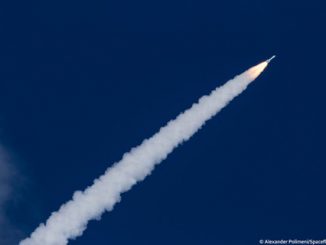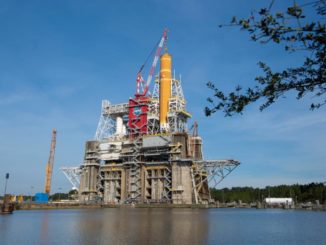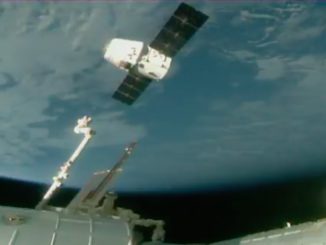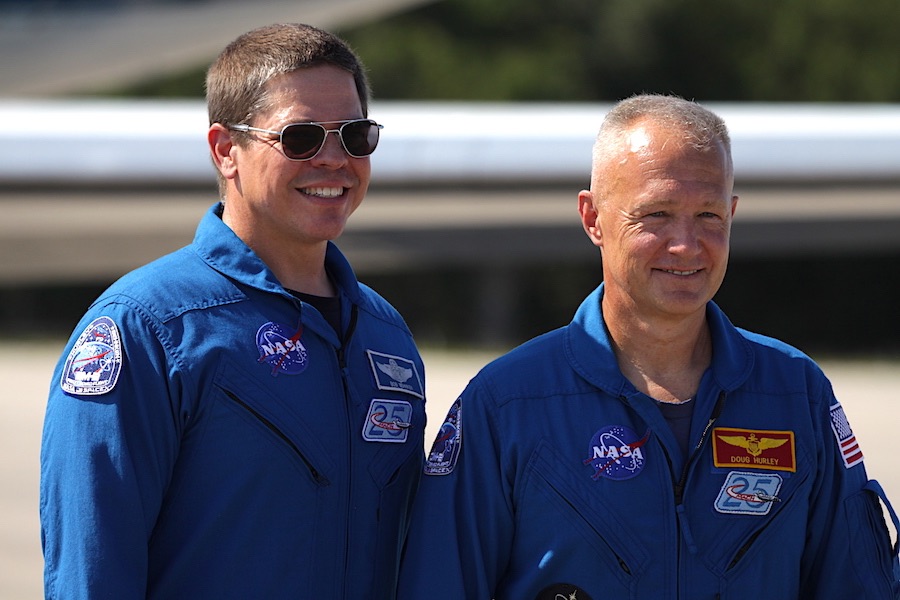
Astronauts Doug Hurley and Bob Behnken arrived Wednesday at the Kennedy Space Center, ready for spacesuit and spacecraft fit checks, and some time off with their families before launching next week on the first crewed flight into orbit from U.S. soil since 2011.
Hurley and Behnken, each veterans of two space shuttle flights, rode a NASA Gulfstream business jet from their home base in Houston to Florida spaceport, where they were greeted by NASA managers and a limited number of reporters and photographers, all wearing masks and observing physical distancing guidelines due to the coronavirus pandemic.
“Both Doug and I are really excited to be here,” Behnken said. “This is an awesome time to be an astronaut with a new spacecraft to get a chance to go and fly.”
The astronauts are scheduled to launch next Wednesday, May 27, from pad 39A at Kennedy aboard a SpaceX Falcon 9 rocket and Crew Dragon spacecraft. Liftoff is set for 4:33:33 p.m. EDT (2033:33 GMT), a time set to allow the Dragon capsule to launch into the same orbital plane of the International Space Station.
Assuming an on-time launch next Wednesday, Hurley and Behnken are slated to dock with the orbiting research laboratory around 11:39 a.m. EDT (1539 GMT) on May 28.
NASA Administrator Jim Bridenstine and Bob Cabana, director of the Kennedy Space Center, welcomed the Dragon crew to Florida’s Space Coast.
“I know times are tough right now,” Bridenstine said. “Bob Cabana and I have been walking around in our masks. Everybody wants to shake hands, and yet we have to resist. We just welcomed our astronauts and we couldn’t shake (their hands). We were waving from six feet away, and we’re looking at all the media that are here, and everybody is wearing their masks. This is a tough time in American history. It’s a tough time in world history.
“But it is not unique,” Bridenstine continued, referring to the unrest of the 1960s.
“We had a war raging in Vietnam, we had protests,” he said. “We had civil rights abuses, and civil rights protests. We had division in this country the likes of which we’ve never seen before, and at the same time NASA was able to unite not just the United States of America, but we were able to unite the world in that very unique moment, where we saw Neil Armstrong and Buzz Aldrin land on the moon.
“Now here we are at this point where NASA has not had access to the International Space Station with its own rockets now for nine years, and this is a moment when we can all look and be inspired as to what the future holds.”
Behnken will serve as the joint operations commander for the Crew Dragon flight, designated Demo-2, or DM-2. The 49-year-old Missouri native will be responsible for the mission’s rendezvous and docking with the International Space Station, along with activities once aboard the orbiting research lab.
Hurley, a retired Marine Corps colonel who hails from Upstate New York, will be the spacecraft commander on the Demo-2 test flight. His responsibilities include launch, landing and recovery operations.
Behnken and Hurley were two of four NASA astronauts selected in 2015 to train for commercial crew missions on SpaceX and Boeing capsules. NASA assigned the two-man crew to the SpaceX Demo-2 mission in 2018.
NASA has signed a series of funding agreements with SpaceX since 2011 valued at more than $3.1 billion. With NASA funding and technical oversight, SpaceX has developed the human-rated Crew Dragon spacecraft to launch on the company’s Falcon 9 rocket.
Boeing has received a similar series of contracts from NASA — valued at more than $4.8 billion — to develop the Starliner crew capsule.
But those figures include NASA payments to the contractors to cover crew transportation services, once the Crew Dragon and Starliner vehicles are operational. Phil McAlister, NASA’s head of commercial spaceflight development, said May 13 that the space agency invested around $5 billion toward Crew Dragon and Starliner design and development.
The companies also put in an unspecified level of private funding, a requirement under the public-private partnership arrangement pursued by NASA’s commercial crew program since 2010.
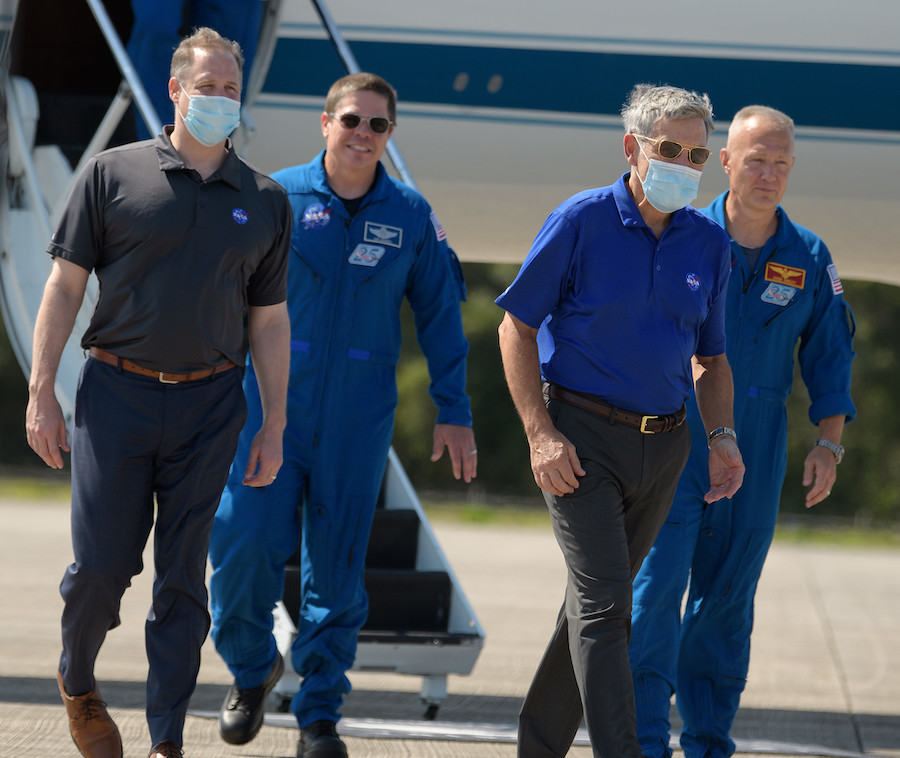
At the time of the space shuttle’s retirement in 2011, NASA hoped to have the commercial crew ships flying astronauts by 2015. But that schedule has slipped, initially due to a lack of funding appropriated by Congress, then by myriad technical delays suffered by SpaceX and Boeing.
“Bob and I have been working on this program for five years, day in and day out, and there are folks here at NASA and at SpaceX, (for whom) it’s been longer than that,” Hurley said. “It’s been a marathon in many ways, and that’s what you would expect to develop a human-rated space vehicle that can go to and from the International Space Station,” Hurley said. “So I think it’s a long time coming in some ways.”
SpaceX completed a six-day unpiloted Crew Dragon test flight, known as Demo-1, to the space station in March 2019. The Crew Dragon has also completed two launch abort tests, one demonstrating the ship’s ability to escape an emergency on the launch pad, and another to prove the capsule can safely fire off the top of a Falcon 9 rocket in flight.
The Starliner program is likely nearly a year from its first piloted spaceflight. Boeing’s first Starliner test flight without astronauts faltered before reaching the International Space Station due to a software error in December, and engineers are wringing out the problems before trying another unpiloted demonstration mission this fall.
Wednesday’s arrival of space-bound astronauts at the Kennedy Space Center was the first such event at the Florida spaceport since July 4, 2011, when the final space shuttle crew jetted to the launch base.
Hurley was the pilot on that mission, giving him the distinction on flying on back-to-back spaceflights taking off from Kennedy.
“When you fly a shuttle flight, by the time you land, you’re just exhausted,” Hurley said Wednesday. “You’re glad that you had a successful mission, and you just want to see your family. I think after that, you think about, ‘OK, what’s next?'”
NASA astronauts continued soaring into space on Russian Soyuz spaceships, logging record-long expeditions on the International Space Station. But Hurley said didn’t know if he would ever fly in space again.
“It’s an evolving thing, and the folks at NASA had a great idea to form a public-private partnership with companies and compete for … and it has ended up in this situation,” Hurley said. “And we’re lucky enough to be on the vehicle. It has been a long road in a lot of ways, but I certainly consider myself lucky to be part of it.”
Behnken and Hurley are expected to spend one to four months on the space station. Since their assignment to the Dragon test flight, the astronauts have completed thousands of hours of training, much of it inside simulators at SpaceX headquarters in Southern California.
After the final full-up launch simulation May 4, the Demo-2 crew wrapped up their official training sessions and entered NASA’s quarantine protocol May 13. Hurley said they completed their final pre-launch “proficiency” session Tuesday in a Dragon simulator at the Johnson Space Center in Houston.
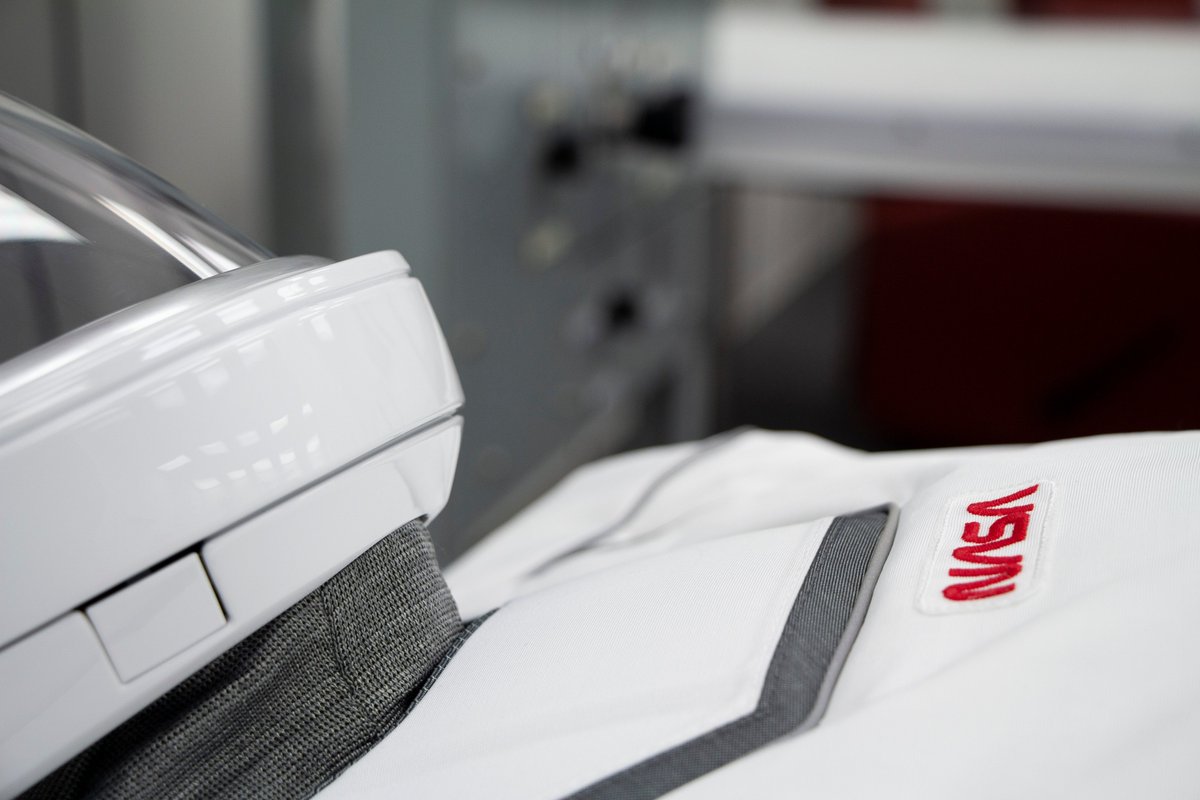
SpaceX teams at Kennedy plan to roll out the Falcon 9 rocket and Crew Dragon spacecraft to pad 39A ahead of a static test-firing of the launch vehicle’s Merlin main engines Friday.
Behnken said he’s looking forward to spending some time with his family at the famed Astronaut Beach House — officially named the Kennedy Space Center Conference Center — where numerous crews have passed time before their space missions
“They’ve been observing a pretty tight quarantine to make that a possibility,” Behnken said of the crew’s families.
On Saturday, Hurley and Behnken will put on their SpaceX-made spacesuits and travel to pad 39A inside a Tesla Model X, an example of cross-branding between two companies founded by billionaire Elon Musk. The astronauts will board the Dragon capsule at pad 39A and run through pre-launch procedures up to the point where the rocket would be fueled during a real countdown.
“We’ll get a chance to put our spacesuits on again to make sure that they’re finally completely up and ready for the actual event,” Behnken said. “We’ll get a chance to climb into the Dragon capsule, strap in and walk through the pre-launch timeline inside the vehicle.
“That’ll involve riding in the Teslas out to the launch pad, going through that whole exercise just to polish the team one more time prior to the launch. Then, of course, the big show in the 27th.”
Email the author.
Follow Stephen Clark on Twitter: @StephenClark1.

